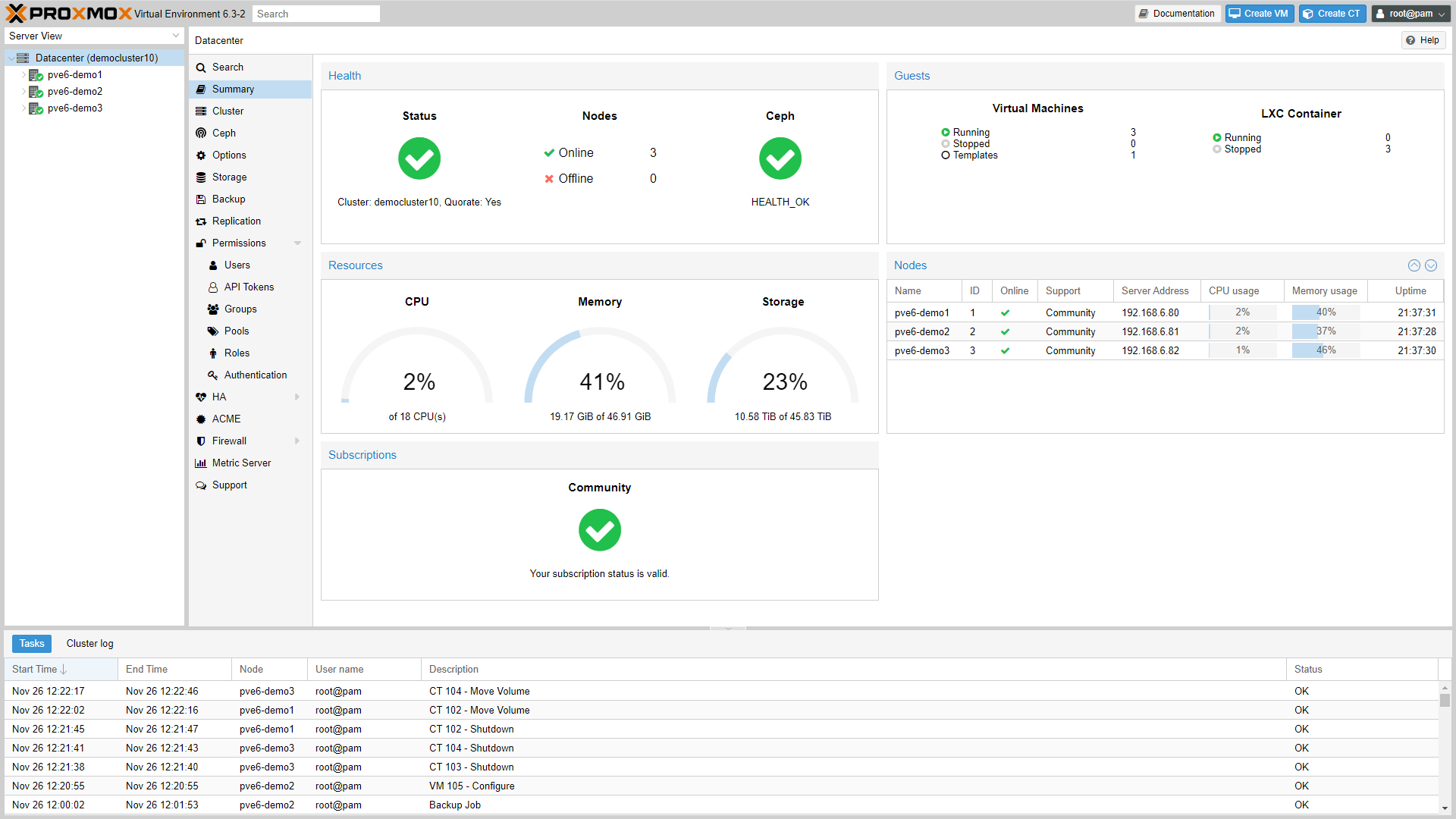Proxmox Virtual Environment is an open-source server virtualization management platform.
It is a Debian-based Linux distribution with a modified Ubuntu LTS kernel and allows deployment and management of virtual machines and containers.
Proxmox VE includes a web console and command-line tools, and provides a REST API for third-party tools. Two types of virtualization are supported: container-based with LXC, and full virtualization with KVM. It comes with a bare-metal installer and includes a web-based management interface.
Features include:
- Maximum flexibility to your production environment.
- Easy management of compute, network, and storage with the central web interface.
- 100% software-defined architecture.
- Two virtualization technologies supported: KVM hypervisor & Linux Container (LXC). Use KVM full virtualization for Windows and Linux images, and lightweight containers to run conflict-free Linux applications.
- Web-based Management Interface:
- Integrated – no need to install a separate management tool or any additional management node.
- Fast, search-driven interface, able to handle thousands of VMs.
- Based on the Ext JS JavaScript framework.
- Secure HTML5 console, supporting SSL.
- Let’s Encrypt TLS certificates via the DNS-based challenge mechanism (or http).
- Fast and easy creation of VMs and containers.
- Seamless integration and easy management of a whole cluster.
- Subscription management via GUI.
Integrated documentation
- Rest API:
- Easy integration for third-party management tools.
- REST like API (JSON as primary data format).
- Easy and human readable data format (native web browser format).
- Full support for API tokens
- Automatic parameter verification (verification of return values).
- Automatic generation of the API documentation.
- Easy way to create command line tools (use the same API).
- Resource Oriented Architecture (ROA).
- Declarative API definition using JSON Schema.
- Command Line:
- Manage all components of your virtual environment.
- CLI with intelligent tab completion.
- Full UNIX man page documentation.
- High-Availability (HA) Cluster Manager:
- No single point of failure (no SPOF).
- Multi-master cluster.
- Manage the HA settings for KVM and LXC via GUI.
- pmxcfs—unique Proxmox VE Cluster File System: database-driven file system for storing configuration files replicated in real-time on all nodes using Corosync.
- Based on proven Linux HA technologies, providing stable and reliable HA service.
- Resource agents for KVM and containers (LXC).
- Watchdog-based fencing.
- Live Migration.
- Built-in services: firewall, backup/restore, storage replication, etc.
- Software-defined storage:
- Local storage such as ZFS (encryption possible), LVM, LVMthin, ext4, and XFS.
- Shared storage such as FC, iSCSI or NFS.
- Distributed storage such as Ceph RBD or CephFS.
- Encryption support for Ceph OSD and ZFS.
- Unlimited number of storage definitions (cluster-wide).
- Complete open-source platform for enterprise virtualization.
- Live migration
- Storage replication stack.
- Virtualized networking:
- Bridged networking model.
- Each host with up to 4094 bridges.
- TCP/IP configuration.
- IPv4 and IPv6 support.
- VLANs.
- Open vSwitch.
- Hyper-converged infrastructure (HCI) with Ceph.
- Proxmox VE Firewall:
- Supporting IPv4 and IPv6.
- Linux-based netfilter technology. Stateful firewall, provides high bandwidth.
- Distributed: main configuration in Proxmox VE cluster file system, iptable rules are stored in nodes.
- Cluster-wide settings.
- 3 levels of configuration (data center, host, VM/CT).
- Support for ‘raw’ tables; enable Synflood-Attack protection.
- Backup and restore:
- Full backups of VMs and containers.
- Live snapshot backups.
- Multiple schedules and backup storage.
- GUI integrations, but also via CLI.
- “Backup Now” and restore via GUI.
- Run scheduled backup jobs manually in the GUI.
- All jobs from all nodes can be monitored via the GUI tab “Tasks”.
- Back up VMs with IOThreads enabled.
- Two-factor authentication.
- Multiple authentication sources:
- Linux PAM standard authentication (e.g., ‘root’ and other local users).
- Built-in Proxmox VE authentication server.
- Microsoft Active Directory (MS ADS).
- LDAP.
- Role-based administration:
- User and permission management for all objects (VMs, storage systems, nodes, etc.)
- Proxmox VE comes with a number of predefined roles (lists of privileges) which satisfies most needs.
- The GUI provides an overview the whole set of predefined roles.
- Permissions to control access to objects (access control lists). In technical terms they are simply a triple containing <path,user,role>. Each permission specifies a subject (user or group) and a role (set of privileges) on a specific path
Website: proxmox.com/en/proxmox-ve
Support: Documentation, Wiki
Developer: Proxmox Server Solutions GmbH
License: GNU Affero General Public License, version 3

Proxmox is written in Perl. Learn Perl with our recommended free books and free tutorials.
| Popular series | |
|---|---|
| The largest compilation of the best free and open source software in the universe. Each article is supplied with a legendary ratings chart helping you to make informed decisions. | |
| Hundreds of in-depth reviews offering our unbiased and expert opinion on software. We offer helpful and impartial information. | |
| The Big List of Active Linux Distros is a large compilation of actively developed Linux distributions. | |
| Replace proprietary software with open source alternatives: Google, Microsoft, Apple, Adobe, IBM, Autodesk, Oracle, Atlassian, Corel, Cisco, Intuit, SAS, Progress, Salesforce, and Citrix | |
| Awesome Free Linux Games Tools showcases a series of tools that making gaming on Linux a more pleasurable experience. This is a new series. | |
| Machine Learning explores practical applications of machine learning and deep learning from a Linux perspective. We've written reviews of more than 40 self-hosted apps. All are free and open source. | |
| New to Linux? Read our Linux for Starters series. We start right at the basics and teach you everything you need to know to get started with Linux. | |
| Alternatives to popular CLI tools showcases essential tools that are modern replacements for core Linux utilities. | |
| Essential Linux system tools focuses on small, indispensable utilities, useful for system administrators as well as regular users. | |
| Linux utilities to maximise your productivity. Small, indispensable tools, useful for anyone running a Linux machine. | |
| Surveys popular streaming services from a Linux perspective: Amazon Music Unlimited, Myuzi, Spotify, Deezer, Tidal. | |
| Saving Money with Linux looks at how you can reduce your energy bills running Linux. | |
| Home computers became commonplace in the 1980s. Emulate home computers including the Commodore 64, Amiga, Atari ST, ZX81, Amstrad CPC, and ZX Spectrum. | |
| Now and Then examines how promising open source software fared over the years. It can be a bumpy ride. | |
| Linux at Home looks at a range of home activities where Linux can play its part, making the most of our time at home, keeping active and engaged. | |
| Linux Candy reveals the lighter side of Linux. Have some fun and escape from the daily drudgery. | |
| Getting Started with Docker helps you master Docker, a set of platform as a service products that delivers software in packages called containers. | |
| Best Free Android Apps. We showcase free Android apps that are definitely worth downloading. There's a strict eligibility criteria for inclusion in this series. | |
| These best free books accelerate your learning of every programming language. Learn a new language today! | |
| These free tutorials offer the perfect tonic to our free programming books series. | |
| Linux Around The World showcases usergroups that are relevant to Linux enthusiasts. Great ways to meet up with fellow enthusiasts. | |
| Stars and Stripes is an occasional series looking at the impact of Linux in the USA. | |
